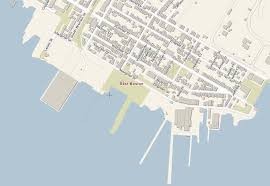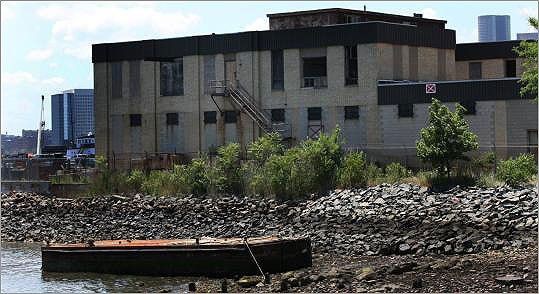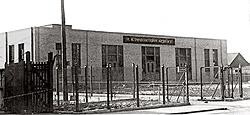East Boston Immigration Station (1920 to 1954)
Introduction
Text-to-speech Audio
The East Boston Immigration Station functioned as the United States Immigration Service’s detention center in Boston from 1920 to 1954. The former immigration station is currently owned by the Massachusetts Port Authority. In 2010, the facilities were demolished, but the building in the East Boston Shipyard was utilized for a variety of purposes prior to that time. Like many parts of the city, this small plot of land reflects change over time.
Images
A contemporary map depicting the location of the East Boston Immigration Station within the surrounding area. Source: Boston Landmarks Commission, Report on the Potential Designation of the East Boston Immigration Station. Amended (2010).

The former building which prior to its demolition in 2010. Source: https://www.pinterest.com/pin/456271005968978614/

A photo of the station along Boston Harbor, likely from 1920s. Photo Credit: Boston Public Library, Source: https://www.cbp.gov/about/history/did-you-know/anna-tillinghast

Backstory and Context
Text-to-speech Audio
Between 1880 to 1920, over 230,000 immigrants seeking economic and social opportunities arrived to Boston from southern and eastern Europe. Only about ten percent of all migrants, however, journeyed through the East Boston station, located on 287 Marginal Street within Boston’s Shipyard and Marina. Before the Immigration Station’s construction plans were formally undertaken in 1907, immigration and Public Health officials had been addressing waves of immigration out of Long Wharf, Boston. [3]
Despite a seemingly comprehensive layout, the Immigration Station faced structural constraints. “Boston's Ellis Island” featured dormitories, recreation and dining rooms, and processing facilities for Immigration officials, but could only accommodate 582 people.[5] Alongside the building’s leaky roof and poor infrastructure, this often left officials screening migrants on ships anyway. [6] The Station also played a curious role as a detention center and site of socio-political throughout the twentieth century: in 1923, textile mill workers protested the arrest and possible deportation of 20-year-old alleged Communist organizer Anna Burlac. [8] Moreover, declining immigration rates and the onset of World War II transformed the East Boston landmark into a Communist detention center holding “enemy aliens.”[9]
After closing, the East Boston Immigration Station served as a radiator factory, TWA storeroom, and junk repository. It was ultimately auctioned off in October 1959 by the federal government and in 2010, the Boston Landmarks Commission ruled the building would not be a protected historical landmark. The buildings have since been demolished and its land is presently owned by the Massachusetts Port Authority.
Sources
[1] Massachusetts Port Authority, comp. The East Boston Immigration Station: A History. Universal, (2012), 3.
[2] Johnson, Marilynn S, The New Bostonians: How Immigrants Have Transformed the Metro Area since the 1960s. Amherst: University of Massachusetts Press (2015), 12-13.
[3] Massachusetts Port Authority, comp. The East Boston Immigration Station: A History. (2012), 4.
[4] Ibid, 4.
[5] "East Boston's Immigration Station," Boston.com. Accessed September 23, 2018.
[6] Boston Landmarks Commission, Report on the Potential Designation of the East Boston Immigration Station. Amended (2010), 4.
[7] Massachusetts Port Authority, comp. The East Boston Immigration Station: A History. Universal, (2012), 4.
[8] 3 Accused as Reds, Strike Chiefs, Held. (1931). The Washington Post (1923-1954), p. 7.
[9] Special to The New York Times. (1931). Textile Strikers Parade in Boston. New York Times (1923-Current File), p. 10.
[10] Boston Landmarks Commission, Report on the Potential Designation of the East Boston Immigration Station. Amended (2010), 22.
[11] Ryan, Andrew. "Panel Rejects Immigration Station as Landmark." Boston.com. May 19, 2010. Accessed September 23, 2018.
[12] Ibid, 23.
[13] Holt, Steve. "Storied E. Boston Immigration Hub to Be Demolished." Boston.com. January 03, 2011. Accessed September 23, 2018.
